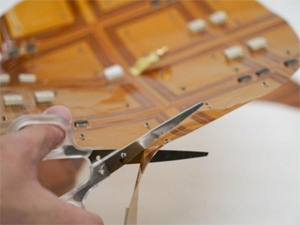



Date:11/01/19
 Researchers from the University of Tokyo have developed a new system to charge electronic devices such as smartphones and smartwatches wirelessly. The method involves a cuttable, flexible power transfer sheet which charges devices wirelessly and can be molded or even cut with scissors to fit different-shaped surfaces and objects.
Researchers from the University of Tokyo have developed a new system to charge electronic devices such as smartphones and smartwatches wirelessly. The method involves a cuttable, flexible power transfer sheet which charges devices wirelessly and can be molded or even cut with scissors to fit different-shaped surfaces and objects.
“I really wish to live in a wireless world,” says Ryo Takahashi of the Graduate School of Information Science and Technology. “Imagine homes and offices without tangled cables, and think how useful it could be for emerging fields like robotics.”
Takahashi is a master’s student whose previous study of robotics inspired him to pioneer ways to power devices such as robots or smartphones simply and easily. This path led him towards the creation of the first-ever cuttable wireless power transfer sheet. It might seem strange to invent something just so it can be cut to pieces, but the idea is users can reshape the sheet to fit whatever surface upon which they wish to charge devices.
“You can do more than just cut this sheet into fun or interesting shapes,” continues Takahashi. “The sheet is thin and flexible so you can mold it around curved surfaces such as bags and clothes. Our idea is anyone could transform various surfaces into wireless charging areas.”
The clever design which allows these novel features is also what separates this idea from existing contactless power chargers. Both systems use conductive coils in the charger to induce a current in corresponding coils in the device. But the cuttable sheet is not only much thinner but has a wider usable charging area thanks to the way the coils are designed. These coils are also wired in such a way that provided enough of them remain intact after the sheet is cut to shape, they can still charge a device.
“Currently a 400-millimeter (15.75-inch) square sheet provides about 2 to 5 watts of power, enough for a smartphone. But I think we could get this up to tens of watts or enough for a small computer,” concludes Takahashi. “In just a few years, I would love to see this sheet embedded in furniture, toys, bags and clothes. I hope it makes technology more invisible.”
Japanese Engineers Create A Wireless Charger You Can Easily Cut To Shape
 Researchers from the University of Tokyo have developed a new system to charge electronic devices such as smartphones and smartwatches wirelessly. The method involves a cuttable, flexible power transfer sheet which charges devices wirelessly and can be molded or even cut with scissors to fit different-shaped surfaces and objects.
Researchers from the University of Tokyo have developed a new system to charge electronic devices such as smartphones and smartwatches wirelessly. The method involves a cuttable, flexible power transfer sheet which charges devices wirelessly and can be molded or even cut with scissors to fit different-shaped surfaces and objects.“I really wish to live in a wireless world,” says Ryo Takahashi of the Graduate School of Information Science and Technology. “Imagine homes and offices without tangled cables, and think how useful it could be for emerging fields like robotics.”
Takahashi is a master’s student whose previous study of robotics inspired him to pioneer ways to power devices such as robots or smartphones simply and easily. This path led him towards the creation of the first-ever cuttable wireless power transfer sheet. It might seem strange to invent something just so it can be cut to pieces, but the idea is users can reshape the sheet to fit whatever surface upon which they wish to charge devices.
“You can do more than just cut this sheet into fun or interesting shapes,” continues Takahashi. “The sheet is thin and flexible so you can mold it around curved surfaces such as bags and clothes. Our idea is anyone could transform various surfaces into wireless charging areas.”
The clever design which allows these novel features is also what separates this idea from existing contactless power chargers. Both systems use conductive coils in the charger to induce a current in corresponding coils in the device. But the cuttable sheet is not only much thinner but has a wider usable charging area thanks to the way the coils are designed. These coils are also wired in such a way that provided enough of them remain intact after the sheet is cut to shape, they can still charge a device.
“Currently a 400-millimeter (15.75-inch) square sheet provides about 2 to 5 watts of power, enough for a smartphone. But I think we could get this up to tens of watts or enough for a small computer,” concludes Takahashi. “In just a few years, I would love to see this sheet embedded in furniture, toys, bags and clothes. I hope it makes technology more invisible.”
Views: 353
©ictnews.az. All rights reserved.Similar news
- Azerbaijani project to monitor disease via mobile phones
- Innovative educational system to be improved under presidential decree
- NTRC prolongs license of two TV and radio organizations for 6 years
- Azerbaijan establishes e-registry for medicines
- Azerbaijani museum introduces e-guide
- Nar Mobile opens “Nar Dunyasi” sales and service center in Siyazan city
- International conference on custom electronic services held in Baku
- OIC secretary general to attend COMSTECH meeting in Baku
- Azerbaijan develops earthquake warning system
- New law to regulate transition to digital broadcasting in Azerbaijan
- Azerbaijani State Social Protection Fund introduces electronic digital signature
- Intellectual traffic management system in Baku to be commissioned in December
- Tax Ministry of Azerbaijan started receiving video-addresses
- World Bank recommends Azerbaijan to speed up e-service introduction in real estate
- Azerbaijan to shift to electronic registration of real estate





















